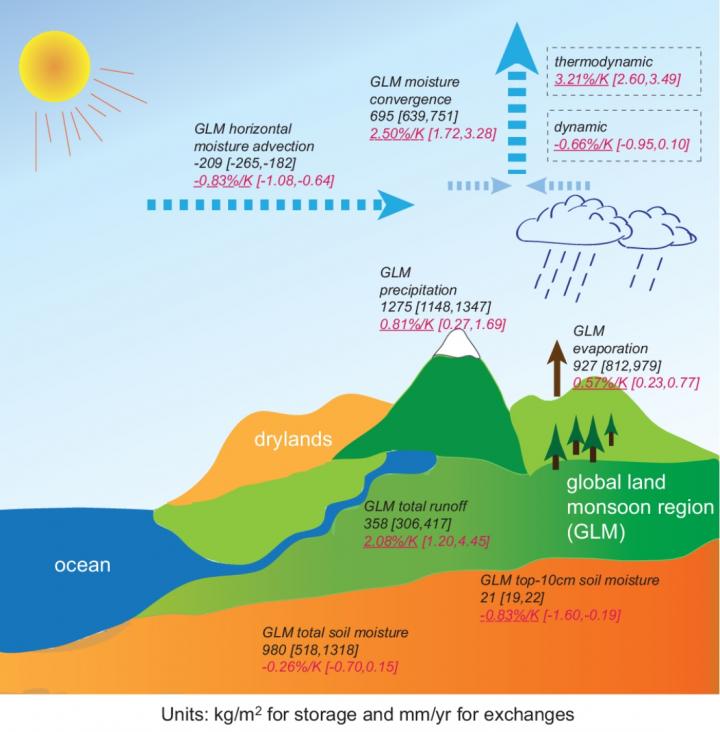
Credit: Wenxia Zhang
The global monsoon region, sprawling north and south from the Earth’s equator, sustains nearly two-thirds of the world’s population. It is characterized with abundant monsoon rainfall, a distinct wet-dry season contrast, and hence an active water cycle.
Future global warming would accelerate the water cycle over the entire global land monsoon region, meanwhile enlarge the wet-dry season contrast, according to a study recently published in Journal of Climate. The research reveals robust and coherent responses in the various aspects of water cycle to future warming over the populous global monsoon regions.
“The global monsoon regions deserve specific attention as they extensively affect the global water cycle,” said Tianjun Zhou, the corresponding author on the paper. Zhou is a senior scientist at the State Key Laboratory of Numerical Modeling for Atmospheric Sciences and Geophysical Fluid Dynamics at the Institute of Atmospheric Physics and CAS Center for Excellence in Tibetan Plateau Earth Sciences in the Chinese Academy of Sciences. He is also a professor at the University of Chinese Academy of Sciences.
While there has been considerable research interest in the future changes in monsoon precipitation, limited attention has been paid to other aspects of the water cycle over the monsoon regions. Zhou and his team, using multi-model output from CMIP5, an archive of the state-of-the-art climate models, investigated and provided a comprehensive picture of water cycle changes over the monsoon regions, including both the atmospheric and surface water sectors, namely, precipitation, evaporation, surface fresh water fluxes, soil water, and total runoff (i.e., water flowing over and within the ground).
“Under future global warming, we will see an accelerated water cycle over the entire global monsoon region, as evidenced by the coherent increases in its various cycling fluxes, including the annual-mean precipitation, evaporation, total runoff and surface fresh water fluxes,” Zhou introduced.
Moreover, the scientists found regional differences under the overall acceleration of water cycle. Specifically, the Northern Hemispheric African, South and East Asian monsoon regions will experience an intensified water cycle, while in the Northern Hemispheric American monsoon region, the water cycle would robustly be weakened. However, the changes in the Southern Hemispheric monsoon regions are largely uncertain.
“Apart from the spatial differences, the water cycle changes also vary with season,” Zhou added. “The precipitation, runoff, and surface fresh water fluxes would increase most prominently in the wet season, but slightly reduce in the dry season. On one hand, this indicates an enlarged wet-dry season contrast in the monsoon regions. In terms of the human use of water resources, the changing seasonality can be described as ‘wet season gets wetter, dry season gets drier’. On the other hand, there might be increasing flood risks in the wet season.”
The water cycle includes both the cycling fluxes (i.e., movements) and reservoirs. The soil water, an important water reservoir in the Earth’s surface, is also an indicator of agricultural drought. “The surface soil water would deplete all year round as a result of atmospheric warming. This could reduce crop yields and further threaten food security for the dense populations,” Zhou added.
These results provide a broader understanding on the redistribution of freshwater resources across the globe induced by future changes in the monsoon system. Meanwhile, the authors are also calling for attention to the changing seasonality of the water cycle. “The seasonal changes are more remarkable and robust than the annual- mean changes,” Zhou said. “We should be aware of and prepared for the potential additional flood and drought risks in the populous monsoon regions.”
###
This work was supported by the National Natural Science Foundation of China, the Strategic Priority Research Program of the Chinese Academy of Sciences, the International Partnership Program of Chinese Academy of Sciences, China Postdoctoral Science Foundation, and Ministry of Science and Technology of China.
Other contributors include Wenxia Zhang, Lixia Zhang, and Liwei Zou, all from the State Key Laboratory of Numerical Modeling for Atmospheric Sciences and Geophysical Fluid Dynamics at the Institute of Atmospheric Physics of the Chinese Academy of Sciences. Lixia Zhang and Liwei Zou are also affiliated with the CAS Center for Excellence in Tibetan Plateau Earth Sciences in the Chinese Academy of Sciences.
Media Contact
Zheng Lin
[email protected]
Original Source
http://english.
Related Journal Article
http://dx.




